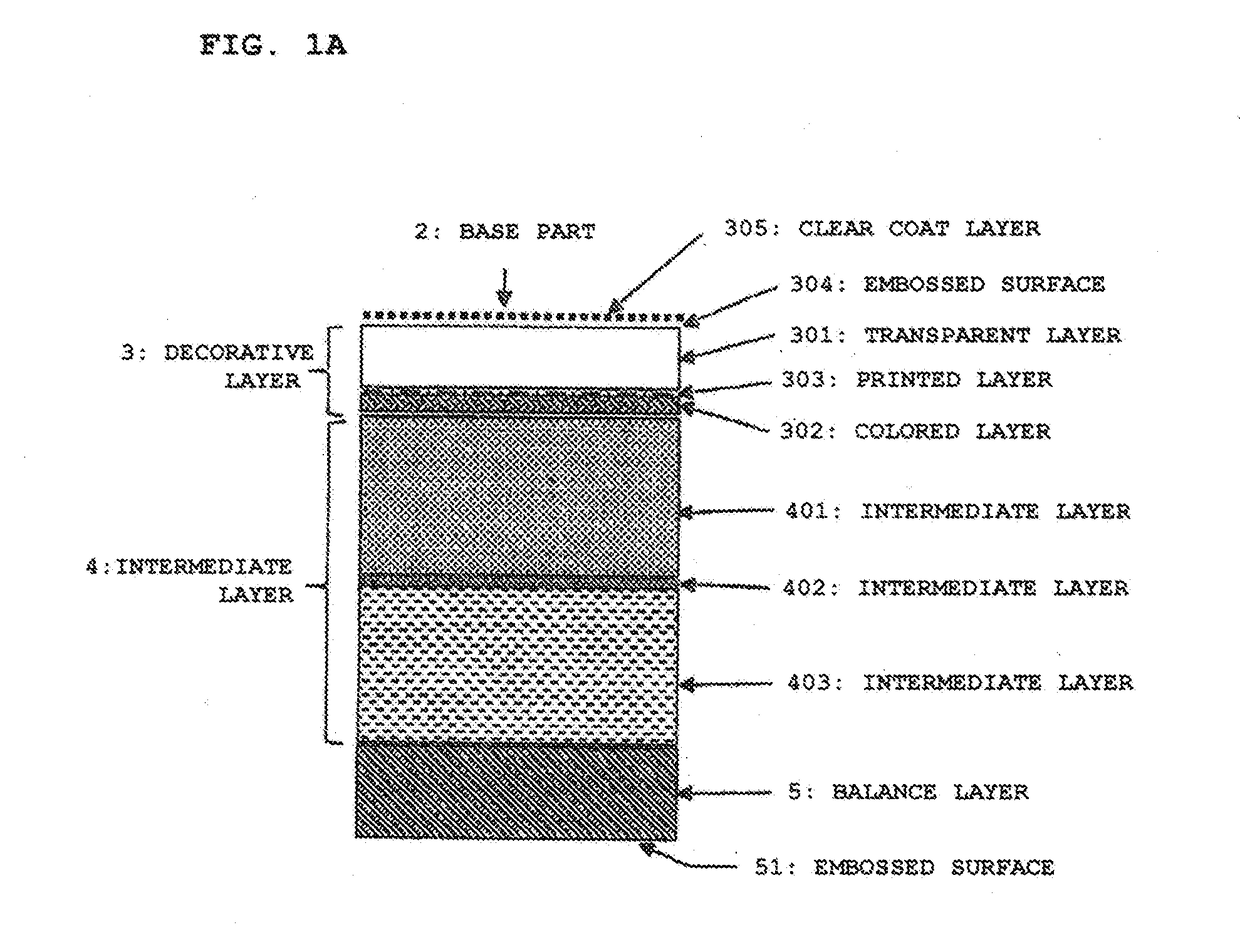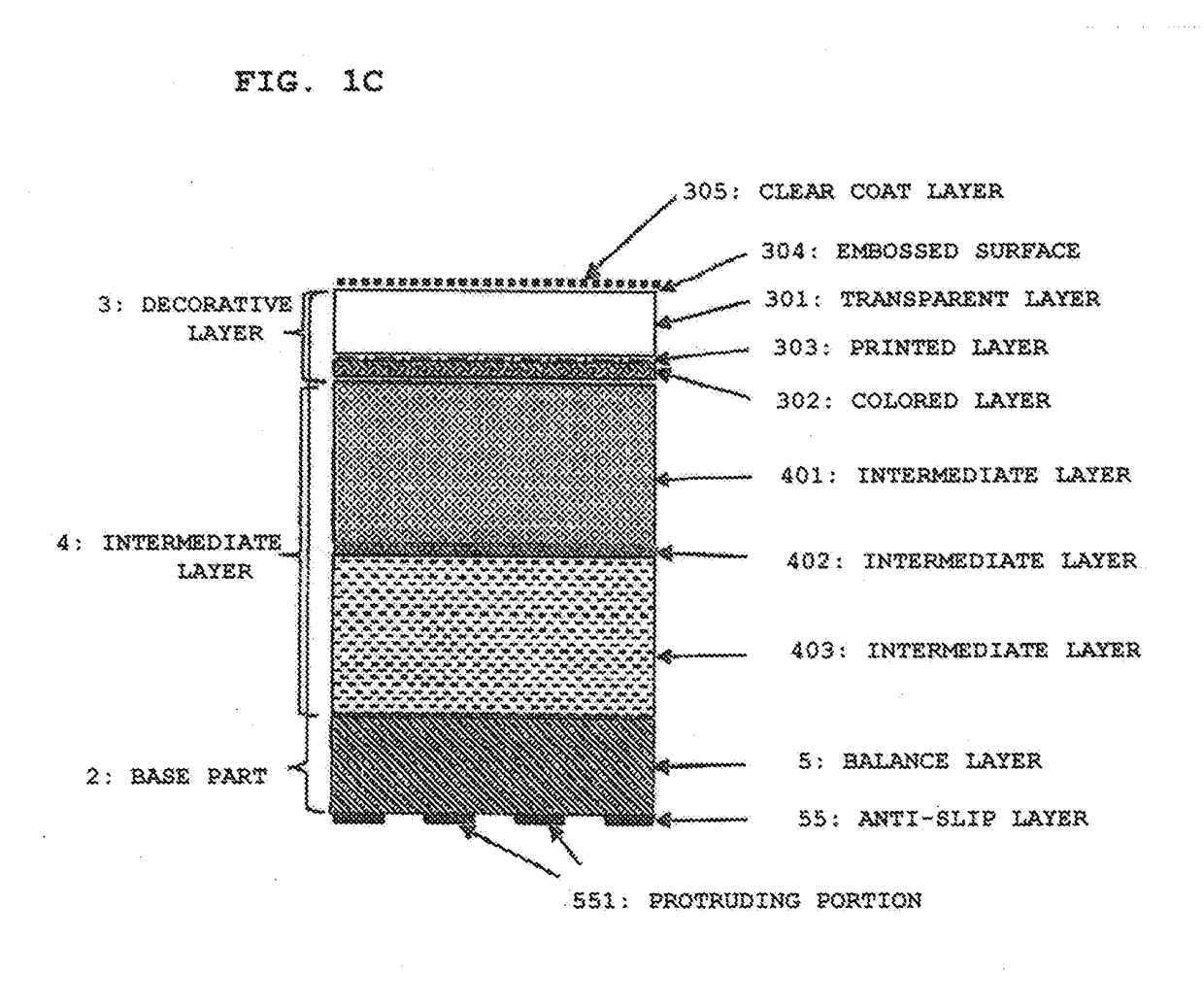Recyclable synthetic resin tile and method of manufacturing the same
a synthetic resin and tile technology, applied in the field of recycled synthetic resin tile, can solve the problems of poor repairability damage to the tile or the floor surface, etc., and achieve the effects of improving conventional defects, good dimensional stability and thermal stability, and easy replacemen
- Summary
- Abstract
- Description
- Claims
- Application Information
AI Technical Summary
Benefits of technology
Problems solved by technology
Method used
Image
Examples
example 1
[0129]The transparent layer 301 had a composition ratio of the olefinic thermoplastic resin (manufactured by Hanwha Total; PP RF 401, hereinafter, referred to as PP) and the olefinic thermoplastic elastomer (manufactured by LG Chemicals; LUCENE LC-100, hereinafter, referred to as LC-100) being 1:1, and a thickness of 0.4 mm. The colored layer 302 had a resin composition ratio of the olefinic thermoplastic resin (PP) and the olefinic thermoplastic elastomer (LC-100) being 1:3, and including 350 parts of the inorganic filler and 10 parts of the coloring agent (titanium oxide), and a thickness of 0.1 mm.
[0130]The intermediate layer 401 had a resin composition ratio of the olefinic thermoplastic resin (PP) and the olefinic thermoplastic elastomer (LC-100) being 4:1, and including 300 parts of the inorganic filler, and a thickness of 0.9 m.
[0131]The balance layer 5 had a resin composition ratio of the olefinic thermoplastic resin (PP) and the olefinic thermoplastic elastomer (LC-100) bei...
example 2
[0132]The transparent layer 301 had a resin composition ratio of the olefinic thermoplastic resin (PP) and the olefinic thermoplastic elastomer (LC-100) being 1:1, and a thickness of 0.5 mm.
[0133]The colored layer 302 had a resin composition ratio of the olefinic thermoplastic resin (PP) and the olefinic thermoplastic elastomer (LC-100) being 1:3, and including 50 parts of the inorganic filler and 10 parts of the coloring agent (titanium oxide), and a thickness of 0.1 mm. The intermediate layer 401 had a resin composition ratio of the olefinic thermoplastic resin (PP) and the olefinic thermoplastic elastomer (LC-100) being 3:2, and including 450 parts of the inorganic filler, and a thickness of 0.7 mm.
[0134]The balance layer 5 had a resin composition ratio of the olefinic thermoplastic resin (PP) and the olefinic thermoplastic elastomer (LC-100) being 5:4 and including 150 parts of the inorganic filler, and a thickness of 0.8 mm.
[0135]Each layer was sequentially and respectively lam...
example 3
[0136]The process was performed in the same manner as in Example 2, except that the tiles manufactured in Example 2 were laid down for 1 month and then collected, and in order to use the product crushed to a 5 mm square, the intermediate layer 403 having the largest thickness (having a resin composition ratio of the olefinic thermoplastic resin (PP) and the olefinic thermoplastic elastomer (LC-100) being 1:1, and including 250 parts of the inorganic filler and 210 parts of the crushed product, and a thickness of 2.3 mm) which is one of the intermediate layers 4 was manufactured. In this case, the thickness was 4.8 mm.
PUM
| Property | Measurement | Unit |
|---|---|---|
| thickness | aaaaa | aaaaa |
| thickness | aaaaa | aaaaa |
| thickness | aaaaa | aaaaa |
Abstract
Description
Claims
Application Information
 Login to View More
Login to View More - R&D
- Intellectual Property
- Life Sciences
- Materials
- Tech Scout
- Unparalleled Data Quality
- Higher Quality Content
- 60% Fewer Hallucinations
Browse by: Latest US Patents, China's latest patents, Technical Efficacy Thesaurus, Application Domain, Technology Topic, Popular Technical Reports.
© 2025 PatSnap. All rights reserved.Legal|Privacy policy|Modern Slavery Act Transparency Statement|Sitemap|About US| Contact US: help@patsnap.com



